How to create narrative paintings (part 3)
This is a follow-up post of the previous two posts (links below) and part 2 of case study Taiwan Forefathers – Reaching Shore
How to create narrative paintings (part 1)
How to create narrative paintings (part 2)
Character changes
Making structuring changes resulted in a very rough composition. The relationship of the characters also had to be restructured and this was what made this painting so difficult to work on. Nevertheless, whenever a character was deleted, their location changed or their pose adjusted, it felt good knowing that I was making progress on the composition.
人物刪改
由於一日改變,畫面粗糙自不待言,更突出的間題是必須重組人物關係。這是畫得很苦的主要原因。每當一個人物刪去;或改變位置和改變動態而使畫面趨好時,眞令人竊喜。
The photos below are a part of the composition that I photographed while making the changes. When we compare the photo to the completed painting, the bent-over man carrying the toolbox in the upper right picture has been removed to create a sense of space. The boatman in the upper left pictured was also removed and is now paddling towards the ship from the left side of the composition. The man carrying a hoe in the lower right had been part of the picture. He felt out of place and his location was too central so he was removed as well. There was also a girl behind the Mazu idol but it was too much of a squeeze and I put her behind the boy instead. The baby on the back of the woman with shoulder pole was taken out as well to avoid putting too much detail into this area. In the lower left, the farmer wearing a straw hat behind the old man was removed as there wasn’t enough room. All of these changes served to clear up and simplify the relationships between the characters in the composition.
下圖是改變過程中拍照下來的畫面局部,比照完成之後的作品,右上圖中那個彎腰揹工具箱的男子去掉了,使這空間豁然開朗。左上圖中的船伕拿掉,換成從畫面左邊划向大船。右下圖曾畫過這一扛鋤男子,似與整體氣氛不協調,而且又太處畫面中心位置,也去掉了。另外,媽姐像後面的姑娘,原來位置太擠,移到男孩身後去,因此層關係,將挑擔婦人揹的小孩刪掉,以免此處太瑣碎。左下圖中,老人背後戴笠農人也因太擠迫而去掉,這樣下來,使畫面人物關係明確而單純化些。
The deletion and re-arrangement of characters is not easy to do on a large canvas. This should’ve been done during the drafting and drawing phases. Much thought went into each character as well, so they weren’t going to quit without a fight. I had to stare long and hard at the painting turning things over mind my head before finally deciding to go ahead with my brush.
人物刪減,重新安排,在大畫布上直接來做是很不容易的事情,這本來是草圖和素描稿的任務。而且,先前每一人物都經過醞釀,先入為主,在腦中盤據了位置,輕易不肯退出,需長久凝視畫面反覆琢磨,才能毅然下筆。
Fortunately for me, I painted with a light hand from the very beginning so it was easy to paint over the top. I was able to make my changes without too much hassle from the materials.
還好,我這幅畫一開始就畫得薄易於覆蓋,減少了修改工作中材料方面的麻煩。
Every character in the composition involved many revisions and a great deal of thought. Sometimes, they were a delight to paint and had their own interest. Nevertheless, they then had to be dropped for the sake of the overall effect.
畫面中的人物每個都經過多次修改和斟酌,有時畫得很爽快,有畫味,但是為了全局,還是要捨棄、割愛。
Character study
形象探索
Farmer
Character study is the most critical and the ultimate mission of portrait painting. If a painting is to have depth, to stand out from the humdrum and ordinary, and to tell a great story, this is where it all comes together.
農民
形象探索在人物畫中最重要也是最終極的任務,一幅畫要有深度,要隔於一般場面鋪陳、說故事的水準,可說全在於此。
The old farmer with a worn reed mat and hoe on his back is honest, loyal and hard-working. Stories of Formosa have filled him with hope. Though he is getting on in years he still plans to rebuild his home there. His mouth is open as if gasping for breath, but there also seems to be a smile from the joy he felt inside. There are tears in his eyes as they gaze at the land ahead. He seems to be saying: “Yes, this is it. I am here at last.”
這個背著破蓆、鋤頭的老農民,忠厚、老實、勤勞,他對傳說中的寶島懷有希望,雖然年紀大了,他還要去重建家園,他的嘴張著,像是喘氣,又微笑意似乎透出發自內心的喜悅。而那對眼睛像含有淚水,凝望前方的土地,心中彷彿默念著:「是了,就是這裡,終於到了。」
The prototype for this image was a retired fisherman from Dongshan Island. The old man had a rough and distinctive look. I incorporated his features into the composition and made two major changes later on. The first big change was to the eyes. The air of uncertainty was changed to deep-set eyes looking straight ahead. The second big change was giving him a short, snub nose typical of Southerners in the region. I toned back the smile as well to make him look slightly out-of-breath. I heaved a sigh of relief when I reached this point in my character study. It took a whole year and several more months before I finally “reached the shore” on the image of this farmer.
這個形象的原型是東山島的退休漁民,這個阿伯形象粗獷,頗有特色,我將其主要特徵放進了畫面,之後作過兩次大變動。第一次大變動是眼睛部位,我將眼睛改成在深陷的眼窩中向前看去,扭轉了原來神態中的不確定性。第二次變動是將高的鼻子改成南方人的短小一點的鼻子,使其地域性明確化,另外,將原來笑意較多的嘴放鬆下來,使其有喘氣的形態,當形象探索至此,我也喘了一口氣,這個農民形象艱難地走了一年幾個月,我這才「抵岸」,形象探索之岸。
I started taking part in farm work such as rice harvests and plantings in Hunan’s farming villages when I was seven or eight years old. For the next twenty or thirty years, I traveled regularly to the countryside to help farmers with their spring planting and fall harvests. I am therefore filled with great respect and gratitude towards farmers who spend their days working in the field. These deep-rooted feelings drove me to continue “hammering” away the composition until I managed to paint an image of the forefathers that can be considered archetypical yet based on real life.
我七、八歲在湖南農村就參加了割稻、插秧的農活,以後二、三十年間都常去農村幫農民春耕、秋收。對常年面朝泥土的農民深懷敬意和感激,這種深層的感情力量使我一直不停地「錘打」畫面,終於畫出一個有生活依據又尙稱典型的先民形象。
The farmers and fishermen from Southern Fujian Province in the lower right corner were the references I used during the creative process. They were mainly used to get a general impression while the character images were being developed. A holistic approach was taken for each study. I didn’t just “deconstruct” and “combine” the facial features, or experimented with different eyes and noses. Everything including the brush size, thickness of the paint and other drawing techniques were adjusted to harmonize the entire composition.
右下方閩南的農民和漁民也是創作時的參照資料,但主要還是作爲形象創造的總體感受提供參考。每次的形象探索幾乎都是全面的,不是將五官去「解構」、「組合」,不是簡單地改個眼睛,換個鼻子,而是包括筆觸大小、顏料厚薄等描繪技巧都需作全面調整,務使畫面有一個完整的整體呈現。
Carpenter
I made the character of the carpenter the soul of the painting. He was a steadfast man who has worked on the docks and built large temples. Smart and bold, he is in front because he has seen the future.
木匠
這個木匠師傳,我把他安排為全畫的靈魂人物,他堅定、穩重,跑過碼頭,建過大廟,有眼光,有膽識,他走在前面,已然看到未來。
When I visited Xiamen in 1992, I met with Mr. Chang-an Chen for the first time. Chen was a painter who taught drawing at the Department of Architecture of Xiamen University. I took photos of him because I was so impressed by his down-to-earth local Minnan (Southern Fujian) look. When I went to Dongshan Island and Shenhu Harbor, I met the boat captains Xi Chen and Shi-bin Chen. I made quick sketches of their heads and also took photos of another boat captain. All of them had a solid, determined and rough-hewn air about them that I drew on for the image of the carpenter. When I revised the composition for the large painting, I kept experimenting with different variations of the same theme.
1992年到廈門,初次見到廈大建築系繪畫教師、畫家陳長安先生時,就深深地被他那閩南漢子的形象所吸引,特地爲他拍了形象特寫,後來去東山島、深滬港,爲船老大陳歹、吳式彬畫了頭像速寫,為另一船老大留下鏡頭,他們都有一種沈穩、堅毅、粗獷的特質,這成爲我創作工匠形象的重要依據和參考。這個形象在大畫布改構圖後就在一個基調中修改探索。
While there weren’t any major changes to this character, I made more changes and repainted this character more times than any other. The location and size kept changing around. I kept having to scrape the paint off and start over due to factors such as the head shape, composure, color, surface and texture.
雖然這個人物沒大變化,但作改動、重畫,也是最多次數的一個,位置、大小幾經變動,常常刮掉再畫,總是因為頭型、神態、色彩、體面、筆觸而等因素折騰不已。
The shape of the lips in the final composition wasn’t as good as previous attempts but I think ultimately some progress was made.
最後的形象,嘴唇的造型尙不及過去,但整體感覺還是有進步的。
Peasant woman
This was one of the key characters in the painting and I was quite satisfied with the final outcome. She has prominent cheeks and brows, slightly jutting chin, rounded forehead, straight nose with slightly flared wings, thin and slightly raised eyebrows, several strands of wet hair, and a bright red ribbon tied to her hair-bun flapping in the breeze… We have a kind, hard-working country woman whose tired eyes have lit up upon seeing the land stretching away in front of her. She was no beauty but she was beautiful all the same. Her stout body is now running forward carrying her heavy boxes with her.
農婦
這是畫中的主要形象之一,最後的結果我頗滿意。她有着明顯的顴骨和眉骨,唇,顎稍突,額頭飽滿,鼻樑直挺而鼻翼微張,細彎而稍稍揚起的眉,幾縲濕髮,髮髻上的紅艷飾帶隨風飄……,這是個善良,勤勞的農家婦人,當她看到土地就在眼前伸展開去時,疲憊的雙眼卻閃耀著明亮的光輝,她不是美人,但是很美。她身子結實,挑著沉重的箱筴往前奔。
Her character appeared in profile in the initial small study. Her position was moved to the front after I started revising the large painting. She now faces the audience directly in a dynamic way so I had to take great care with her appearance. Many portrait techniques such as variation in thickness of oil paint and brush strokes were employed when working on this particular head. She was the only one that I gave bright eyes to out of all the characters depicted in the painting.
她的形象在開初小草圖中就以側面出現,畫大畫改畫後,位置移前了,動態是近正面的對著觀衆,因此,這一形象的塑造使我絕不可稍微輕忽。這個頭像在油畫色層的厚薄,筆觸粗細的節奏等技法處理上都較爲完整。再全畫所有人物的描繪上,也只有她,我給了一對光亮的眼睛。
This image was vague to start with. I couldn’t just transplant the plein-air portrait of a Hui’an woman either. I had asked a girl to model for me in order to check the pose. I found the basis for this image in her distinctive facial features and kind eyes. The basic look was established over several drawings. She started out looking healthy and confident, but I changed that to looking thin and tired at one point. When the painter Ming Xu dropped by my studio and saw this version, he thought it looked ugly and suggested that I should aim for a look that said “Mother of the Taiwanese people.” I ran with it as I thought it was a great idea and finally came up with what we see today. There is just something soothing about this image of a peasant woman.
當然,這形象最初是模糊的,寫生的惠安婦人頭像也不能直接搬過來。當我請到一位姑娘作模特兒核對動作時,我在她明顯的頭部造型和善良的眼神中找到了這一形象的基礎,經過多次描繪後基本造型確立起來,中間也曾由健康、自信的神態,一度改變爲疲勞,而且瘦削的形態,畫家徐敏來畫室看見後認爲有醜陋之嫌,提出「台灣人的母親」的形象方向,所言極是,我再作一番摸索,終於達到今天的這個狀態,我走過來了,眞的,面對這農婦形象,心中有種踏實的安慰。
As I write these words, I imagine how the Russian masters Repin and Surikov must have spent years in contemplation before the canvas as they “hammered” away at the imagery in their mind. From that emerged the very life-like and artistic images we see in Repin’s Barge Haulers on the Volga, the populist revolutionary in Unexpected Return, and Ivan the Terrible Killing his Son, as well as Surikov’s Boyarina Morozova, the Streltsy facing execution, and the disgraced Menshikov. These images inspire me to keep going. I believe with all my heart that only artistic images that are moving and true-to-life can break down the invisible wall between the audience and the canvas!
走筆至此,想像着俄國大師列賓和蘇里柯夫一定是常年在畫布前沉思、「錘打」,找尋那心中的形象之夢,最後才有列賓的「伏爾加河上的織夫」、「意外歸來」裏的民粹派革命者、殺死兒子的沙皇——恐怖依凡和蘇里柯夫的「女貴族莫洛卓娃」、臨死的近衛兵、失意的緬希柯夫等等生動而充滿藝術眞實的形象,至今激勵着我要奮鬥不息。我深信,只有生動感人的藝術形象,才能打破觀衆和畫布中間那無形的牆!
Old man
What I initially put down on canvas was based on a retired fisherman. At the time, I thought he looked somewhat like a Native American. I went back over this many times and while I am happy with the expression of the final version, the previous versions were probably better in terms of technique. If I must choose between the two, I will always go with the mental state of the image. I remember visiting the Louvre in Paris when I visited Europe in the 1990s where I viewed several large character portraits by Delacroix. When you look at it up close, the colors and textures of the character’s head seemed to be on the weak side. From a distance however the characters really leapt out at you and the images were very expressive. I realized then that the fundamentals of drawing are essential to the creation of characters.
老人
當初是以一個退休漁民作藍本搬到畫布上,那時看,很有些美國西部印第安人的味道,後來也反覆畫了很多次,最後定稿的形象在表情上是我要的了,但在描繪技巧上恐怕還是以前的好些,如果在兩者一時不可兼得的情況下,我還是會選擇形象的精神狀態。記得早幾年到巴黎羅浮宮看德拉克洛瓦的幾幅大型人物畫創作,近看人物的頭部色彩、筆觸趣味都較弱,但一退遠,人物造型卻很強,形象表情力度也大,悟出素描基礎仍是塑造人物的根本手段。
Woman with bundle
I painted this woman so many times because the head was hard to get right. I used sketches as a reference but discovered that putting too much emphasis on facial features made the profile look off. It took a great deal of effort to arrive at the result we see now. I must admit that I have no idea what more I can do with this.
扛包袱的女人
這女人畫好多次,頭的動態十分難於捕足好,也曾以寫生素材作參考,卻發現女性的側面形象,太強調五官特徵就不舒服,好不容易畫到如今的樣子,說實好,我再也不敢動多一筆了。
The girl with the basket on her head is the only person not looking straight ahead. Her attention is probably on the heavy, wet bundle in her hand. The curved beauty in her pose may be rather artistic but it’s still within reason. I wanted to use this to give the triangle-shaped crowd a strong, forceful finish. The right hand holding the basket flows on to the boatman, ship and the sails in the distance.
頭頂籃子的姑娘是唯一目光没有看著前方的人,她顧著左手沈濕的包袱吧,她的動態確實有些曲線美感,有唯美之嫌,不過,尙不違動作之常理。我想以此將三角形的人群作一有力的結尾,並以扶著籃子的右手引向船夫、大船,直向遠方的船帆。
All the characters in the painting such as the young man carrying an erhu, the youth holding the Mazu idol, the bare-chested man pointing to the front, the girl with a scarf over her hair, the farmer in a straw hut, the boatman, the ship, the sky, and the waves were all changed again and again to arrive at what we see today. I won’t go into the details though to save space.
畫中人物如帶二胡的青年,抱媽祖的少年,手指向前方的赤膊男子,包頭巾的姑娘,戴竹笠的農民,搖船的船伕,船、天空、海浪無不修改再三,才達今天的面貌。由於篇幅有限,不能一一細述。
I recently wondered: How would I paint this subject again today? My conclusion was that I’d start from scratch! There are too many parts that I am not satisfied or happy with. This painting is therefore just a record of my thoughts up to this day.
近來思忖:如果再畫這題材我會怎樣畫?結論是另起爐灶!因爲仍有好多的不滿意和不滿足。這幅畫只是我今日走來所思所做的一個紀錄罷。

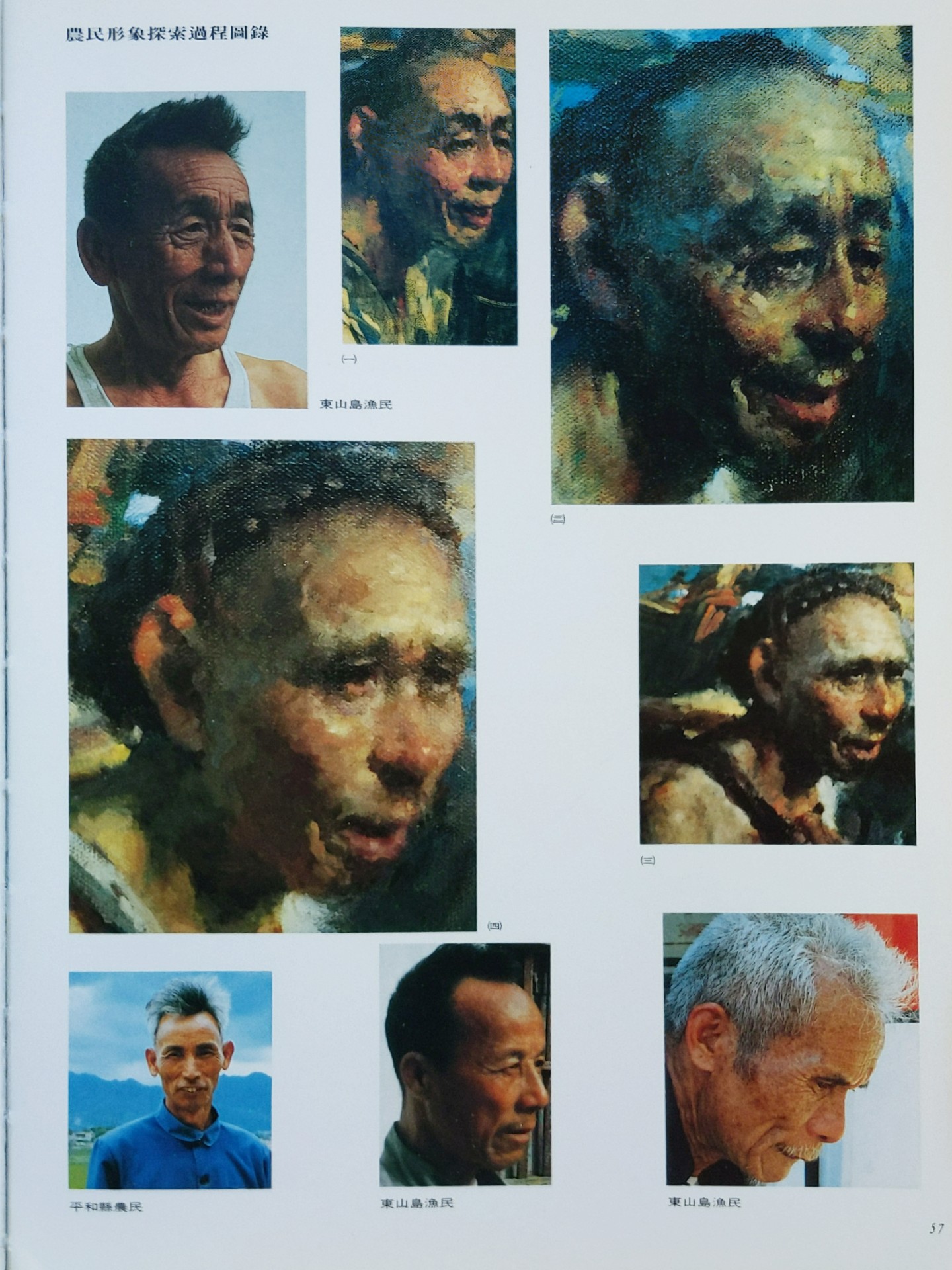
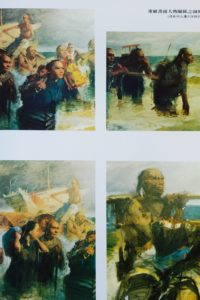
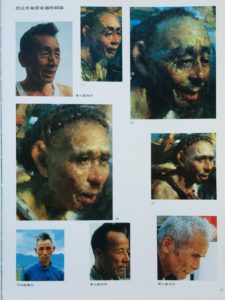
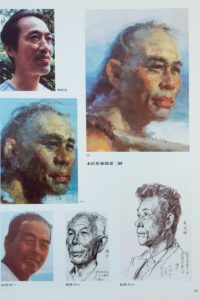
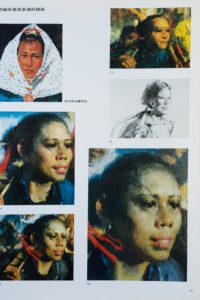
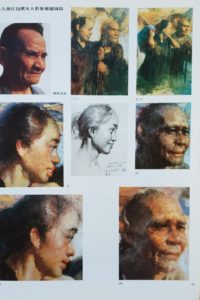

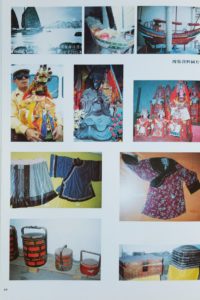

Thank you for sharing.
wow, so awesome sir, what are your basic flesh colors? thanks, your a great artist and a teacher!
Thank you for your kind words. This video will answer your questions about mixing colors for portraits https://www.youtube.com/watch?v=CYcJsgXDsiY&list=PLiB53e7PaWz8FB7_Cwi5MrZI72_w1kYMK&index=5.